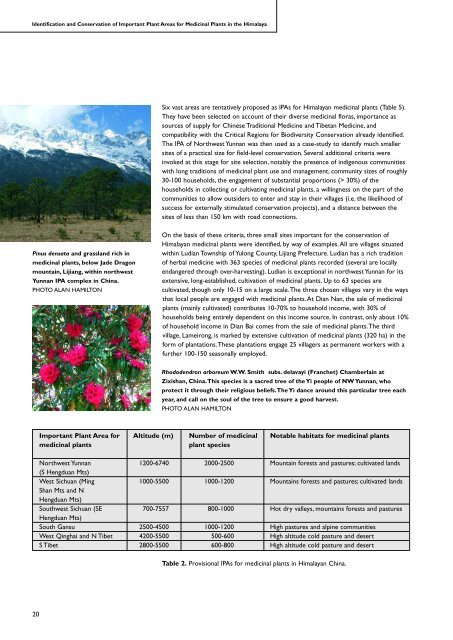Identification and Conservation of Important Plant Areas - Plantlife
Identification and Conservation of Important Plant Areas - Plantlife
Identification and Conservation of Important Plant Areas - Plantlife
- No tags were found...
You also want an ePaper? Increase the reach of your titles
YUMPU automatically turns print PDFs into web optimized ePapers that Google loves.
<strong>Identification</strong> <strong>and</strong> <strong>Conservation</strong> <strong>of</strong> <strong>Important</strong> <strong>Plant</strong> <strong>Areas</strong> for Medicinal <strong>Plant</strong>s in the HimalayaSix vast areas are tentatively proposed as IPAs for Himalayan medicinal plants (Table 5).They have been selected on account <strong>of</strong> their diverse medicinal floras, importance assources <strong>of</strong> supply for Chinese Traditional Medicine <strong>and</strong> Tibetan Medicine, <strong>and</strong>compatibility with the Critical Regions for Biodiversity <strong>Conservation</strong> already identified.The IPA <strong>of</strong> Northwest Yunnan was then used as a case-study to identify much smallersites <strong>of</strong> a practical size for field-level conservation. Several additional criteria wereinvoked at this stage for site selection, notably the presence <strong>of</strong> indigenous communitieswith long traditions <strong>of</strong> medicinal plant use <strong>and</strong> management, community sizes <strong>of</strong> roughly30-100 households, the engagement <strong>of</strong> substantial proportions (> 30%) <strong>of</strong> thehouseholds in collecting or cultivating medicinal plants, a willingness on the part <strong>of</strong> thecommunities to allow outsiders to enter <strong>and</strong> stay in their villages (i.e. the likelihood <strong>of</strong>success for externally stimulated conservation projects), <strong>and</strong> a distance between thesites <strong>of</strong> less than 150 km with road connections.Pinus densata <strong>and</strong> grassl<strong>and</strong> rich inmedicinal plants, below Jade Dragonmountain, Lijiang, within northwestYunnan IPA complex in China.PHOTO ALAN HAMILTONOn the basis <strong>of</strong> these criteria, three small sites important for the conservation <strong>of</strong>Himalayan medicinal plants were identified, by way <strong>of</strong> examples.All are villages situatedwithin Ludian Township <strong>of</strong> Yulong County, Lijiang Prefecture. Ludian has a rich tradition<strong>of</strong> herbal medicine with 363 species <strong>of</strong> medicinal plants recorded (several are locallyendangered through over-harvesting). Ludian is exceptional in northwest Yunnan for itsextensive, long-established, cultivation <strong>of</strong> medicinal plants. Up to 63 species arecultivated, though only 10-15 on a large scale.The three chosen villages vary in the waysthat local people are engaged with medicinal plants.At Dian Nan, the sale <strong>of</strong> medicinalplants (mainly cultivated) contributes 10-70% to household income, with 30% <strong>of</strong>households being entirely dependent on this income source. In contrast, only about 10%<strong>of</strong> household income in Dian Bai comes from the sale <strong>of</strong> medicinal plants.The thirdvillage, Lameirong, is marked by extensive cultivation <strong>of</strong> medicinal plants (320 ha) in theform <strong>of</strong> plantations.These plantations engage 25 villagers as permanent workers with afurther 100-150 seasonally employed.Rhododendron arboreum W.W. Smith subs. delavayi (Franchet) Chamberlain atZixishan, China.This species is a sacred tree <strong>of</strong> the Yi people <strong>of</strong> NW Yunnan, whoprotect it through their religious beliefs.The Yi dance around this particular tree eachyear, <strong>and</strong> call on the soul <strong>of</strong> the tree to ensure a good harvest.PHOTO ALAN HAMILTON<strong>Important</strong> <strong>Plant</strong> Area for Altitude (m) Number <strong>of</strong> medicinal Notable habitats for medicinal plantsmedicinal plantsplant speciesNorthwest Yunnan 1200-6740 2000-2500 Mountain forests <strong>and</strong> pastures; cultivated l<strong>and</strong>s(S Hengduan Mts)West Sichuan (Ming 1000-5500 1000-1200 Mountains forests <strong>and</strong> pastures; cultivated l<strong>and</strong>sShan Mts <strong>and</strong> NHengduan Mts)Southwest Sichuan (SE 700-7557 800-1000 Hot dry valleys, mountains forests <strong>and</strong> pasturesHengduan Mts)South Gansu 2500-4500 1000-1200 High pastures <strong>and</strong> alpine communitiesWest Qinghai <strong>and</strong> N Tibet 4200-5500 500-600 High altitude cold pasture <strong>and</strong> desertS Tibet 2800-5500 600-800 High altitude cold pasture <strong>and</strong> desertTable 2. Provisional IPAs for medicinal plants in Himalayan China.20
















